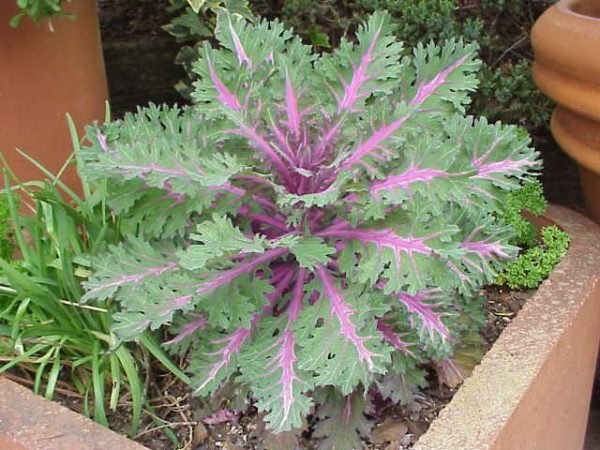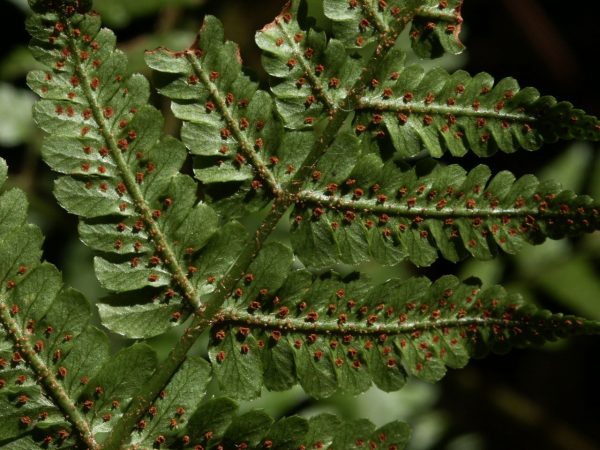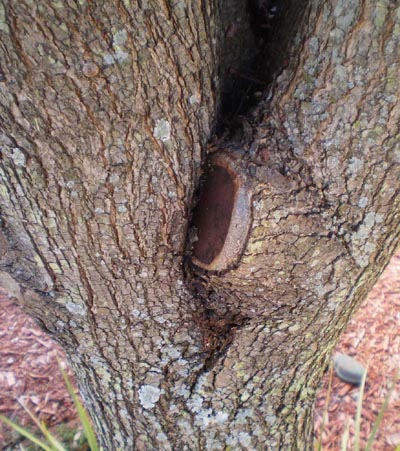Ornamental Kale/Ornamental Cabbage

Ornamental kale and cabbage are some of the most popular (behind the pansy) winter annual plants. They lend a completely different texture to a winter landscape bed. The scientific name is Brassica oleracea
The following plant description was written by Jimmy Turner – Director of Research, Dallas Arboretum
Foliage plants often get overlooked when it comes to flowerbeds and containers. This is especially true during fall planting schemes. Ornamental kale is one of the easiest bedding plants to grow, looks great all through the cool season, is bothered by few pests – and it’s edible! At the Dallas Arboretum I have 66 acres to cover with bedding plants every fall, and I rely heavily on ornamental kale.
The large plants cover a lot of space quickly for a small investment, and require very little maintenance. The colorful foliage also makes a beautiful backdrop for flowering plants such as pansies, violas and tulips. The terms “ornamental kale” or “ornamental cabbage” and “flowering kale” or “flowering cabbage” can be misleading. First, none of them is grown for its “flower,” but the attractive colored winter foliage. Secondly, kale and cabbage (whether ornamental or not) are genetically the same plant. The only difference is cabbages make heads, and kale do not. All “ornamental” cabbages and kales are really kale, since they do not form heads.
The term “ornamental cabbage” is usually used to refer to varieties with unruffled leaves such as ‘Osaka’. Another problem for consumers is the use of “Red” in variety names. There is no true red kale, least not that I have found yet. “Red” kale is usually some shade of dark purple to rose. Some of my favorite varieties are: ‘Red Bor’ a tall variety with deep purple, ruffled leaves. This variety is the tallest usually grown and can reach 3 feet tall. One of the few winter annuals that actually gives us height in the landscape.
‘Peacock Red’ and ‘Peacock White’ form large open plants up to 2 feet across with leaves that are shaped like abstract feathers. ‘Red Feather’ and ‘White Feather’ resemble ‘Peacock Red,’ but they are larger and have less serrated foliage. ‘Nagoya Red’ and ‘Nagoya White’ form tight balls of heavily ruffled foliage. ‘Nagoya Red’ has bright rosy-purple centers on dark purple plants. ‘Osaka Pink,’ ‘Osaka White’ and ‘Osaka Red’ are usually called ornamental cabbage for their smooth, flat leaves. The bottom half of their foliage remains green, while the center rosettes turn bright purple, pink or white. The overall effect resembles a huge flower.
Kale transplants in the fall will usually be green in color. The bright foliage colors will only appear after the first hard frost. For the best foliage color grow them in full sun. Plants will tolerate some light shade, but usually will not be as colorful and tend to lean away from the shadows. Kale are very heavy feeders, so fertilize them frequently to keep them in good growth.
Once the plants are hardened by cooler night temperatures they can survive most Texas winters. If we have unusually warm weather followed by severe dips in temperature the plants may burn, but they will normally recover. Ice storms are the biggest threat to losing plants. If leaves are left covered in ice for prolonged periods they will usually turn to mush. I recommend covering if the forecast predicts freezing rain.
When purchasing your plants, I would not recommend planting from 4-inch pots. Those smaller plants usually become stunted and do not grow as large as 1-gallon transplants. Once kale plants begin to “head-up” they do not grow much wider.
The number one pest of kale both ornamental and the garden varieties is cabbage looper, a small green caterpillar. A plant can be defoliated in a few days. Look for multiple holes in the leaves, with the caterpillars hiding under the foliage. The best control is Bt (Bacillus thuringiensis) a natural bacterial control that must be sprayed frequently. Rabbits can also be a problem! As of yet, I haven’t found a truly effective means to control them.
At the Dallas Arboretum you can see multiple varieties of ornamental kale throughout the garden. The Dallas Arboretum is located at 8525 Garland Road, overlooking White Rock Lake. For more information, visit www.dallasarboretum.org.

ornamental kale











